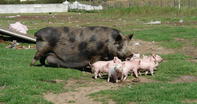When starting a pig farm, you need to choose a breed that would suit your level of skill and management. According to Pigs for Profit by Drs Jim Robinson and Mary Louise Penrith these breeds can be divided into two major groups, namely unimproved and improved breeds.

The unimproved pigs are usually local or indigenous breeds, such as the locally bred Kolbroek or SA Landrace, which are suited for free range and more extensive production systems. Whereas the improved breeds are modern breeds, such as the Large White or Duroc, primarily used in intensive commercial production systems.
The unimproved breeds are a good option if you are a beginner with little experience with pigs, if you are unable to provide the quality of housing and feed needed by a modern pig and if you have a market that would accept or prefer this type of pig.
What’s more, you will not have to get rid of all your pigs if you later want to upgrade to a higher level of management, but can merely use a modern boar or artificial insemination on your sows to improve the productivity in your piggery.
Unimproved Breeds
These breeds are usually black skinned with long black or spotted coats rendering them less vulnerable to sunburn. They are generally hardy, able to tolerate a wide range of temperatures, resistant to diseases and require little management making them ideal for free-range or village production.
They also have low water and feed requirements, but will obviously perform better the more you feed and take care of them. While these breeds usually have good mothering instincts, the sows produce small litters with only five to eight piglets, although this might be more if they are well-fed.
Another drawback is that they are small to medium sized and tend to produce a lot of fat. It is therefore important to secure a market where there is a demand for this meat, before starting a piggery venture with these breeds.
Improved Breeds

These breeds are usually large white-skinned pigs with fine sparse white hair, which renders them vulnerable to sunburn. They easily suffer from heat stress when temperatures get too hot. They are not as resistant to diseases as the unimproved breeds and require sound management, good quality feed and water to perform well.
On the plus-side they are highly productive, producing litters of ten and more piglets at a time. Sows might however sometimes need assistance with the raising of their piglets. They produce little fat in relation to the amount of meat produced, in comparison with unimproved breeds.
By Glenneis Kriel